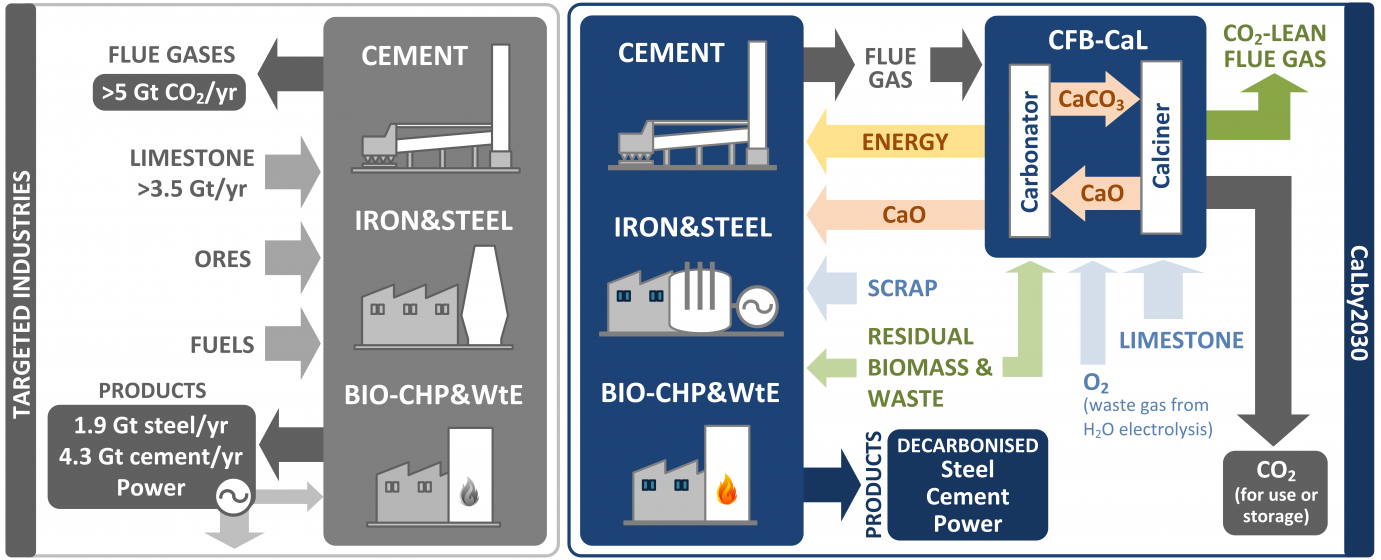OVERVIEW OF THE PROJECT
NEWSLETTER
The main goal of CaLby2030 is to act as enabling tool to achieve, by 2030, commercial deployment of Calcium Looping technology (CaL) using Circulating Fluidised Bed reactors (CFB). CFB-CaL technology is flexible and can be used in numerous industrial sectors. Three pilot plants will be operated in relevant industrial environment across Europe (in Sweden, Germany and Spain), and experimental tests campaigns will be carried out under industrially relevant operating conditions with the aim of reaching >99% CO2 capture rates. Within CaLby2030, to maximize the impact, the pilots will investigate the decarbonisation of hard to abate CO2 emission sources:
- emissions from modern cement plants that cannot escape from the use of limestone - Germany;
- flue gases from steel-making processes - Sweden; and
- flue gases from Waste-to-Energy and Bio-CHP power plants that fill the gap in scalable dispatchable power and allow for negative emissions - Spain.
The data that will be generated under over 4000 hours of operations will be interpreted taking into account cluster optimization and using advanced modelling tools, to enable the scale-up of the key CO2 capture reactors to fully commercial scale before 2030.
The consortium includes the world-leading CFB process technology developer, key end user industries and leading academics including CaL pioneers.
Focus on CaL technology
CaL is an emerging CO2 capture technology, that uses CaO as a sorbent for the capture of CO2 in a carbonator reactor, forming CaCO3. In a subsequent calcination step, a highly-concentrated stream of CO2 is obtained while regenerating CaO. Several reactor concepts have been proposed to conduct the exothermic CaO carbonation and endothermic CaCO3 calcination reactions in the calcium loop, but CFBs using oxy-combustion in the calciner are known to benefit from the maturity of similar CFB Combustors. CaL is most suitable when the high temperature heat flows available from the capture system are effectively integrated in the industrial process or used to generate power. Therefore, CaLby2030 will focus only on high temperature industrial processes, which together account for more than 5 Gt CO2/yr (Figure below, left) and offer strong material synergies and additional CO2 avoidance by utilising the CaO-rich purge leaving the CFB-CaL system. Such capability of the CaL process to displace the intensive use of limestone as raw material in these industries today is what offers a competitive advantage to CaL when it comes to capture CO2 in the targeted industries. Furthermore, as also represented in the right part of Figure below, CFB-CaL looping can profit from the known fuel flexibility of CFB combustion power plants and the future availability of low cost O2 as water electrolysis is deployed to produce hydrogen.

OTHER RELEVANT PROJECTS RELATED TO CCUS IN THE INDUSTRY
- HERCCULES is a Horizon Europe project aiming at developing an integrated and replicable approach for the implementation of the whole CCUS chain in two strategic sectors of the circular economy: cement and energy from waste – http://www.herccules.eu
- C4U is a project funded by the EU H-2020 RFCS (GA 884418). This project spans demonstration of two packed bed capture technologies for optimal integration into an iron and steel plant. CSIC develops the Ca-Cu Looping technology, involving sorption enhanced water gas shift of the CO contained in Blast Furnace Gases to produce H2 while capturing the CO2 as CaCO3, with regeneration of the CaO sorbent using CuO/Cu chemical loop. – https://c4u-project.eu/
- ACCSESS is a four-year Horizon 2020 project that aims to demonstrate technologies and produce tools and plans that enable widespread CCS deployment in Europe - https://www.projectaccsess.eu/
- CCUS ZEN enables knowledge sharing between different stakeholders and between European regions to support full chain development of CCUS.By drawing on learnings from ongoing and past projects, CCUS ZEN aims to build a coherent ecosystem of CCUS actors capable of decarbonising Europe’s industry and delivering the European Union’s climate target plan. - https://www.ccuszen.eu/
- HiRECORD In a world’s first, HIRECORD will demonstrate a 10t/d CO2 capture plant using Rotating Packed Bed (RPB) absorber and desorber with the APBS-CDRMax solvent - http://hirecord.eu/
- PilotSTRATEGY is investigating geological CO2 storage sites in industrial regions of Southern and Eastern Europe to support development of large-scale carbon capture and storage (CCS) - https://pilotstrategy.eu/